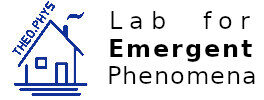Master thesis – Michael Fischer
Michael Fischer
Thermodynamic stability of the novel tricontinuous 3ths(5) structure in self-assembled melts of triblock star-copolymers
[PDF]
finished 2014-02
supervised by Gerd Schröder-Turk
Abstract
Copolymeric self-assembly provides an efficient route to the formation of ordered three-dimensional nanostructures. A well known example are diblock copolymers which are macromolecules that consist of two chemically different but covalently linked polymer chains. Due to the immiscibility of chemically distinct polymer species one observes a variety of morphologies that self-assembly in melts of these molecules. The most complex equilibrium mesophase being observed in diblock copolymer melts is the core-shell Gyroid, based on the bicontinuous intergrowth of two continuous network domains. Adaption of the molecular architecture, such as the introduction of a third chemically distinct species, is a proven strategy to achieve different phases, stabilising e.g. the alternating Gyroid and the Fddd network phase in linear triblock copolymers, or kaleidoscopic columnar phases in star-shaped triblock terpolymers. However, the formation of phases based on the intergrowth of more than two network domains has not yet been reported in copolymer melts. In this thesis we show that a triply-periodic tricontinuous structure based on the intergrowth of three distorted chemically distinct ths nets, thus denoted 3ths(5), is a thermodynamically stable equilibrium phase of star-shaped triblock copolymers when a fourth phase, an extended molecular core, is introduced into the molecular architecture. This tricontinuous morphology has long-range crystalline order but low symmetry, in contrast to most other self-assembled mesophases. We use the spectral method of the self-consistent field theory for polymers to confirm the geometric intuitions, gained from analytical expressions in the strong segregation limit, why the introduction of an extended core leads to the formation of this new phase. Its effect is a change in the relative importance of interface tension between the three initial polymeric species and entropic chain stretching contributions to the free energy. As a consequence, the arrangement of the molecular cores on a close-packed lattice of lines is favored. Beyond the prediction of the first tricontinuous network phase in copolymer melts, this study discusses the existence of two new columnar phases and suggests the utilization of molecular cores as a new general concept for extending the range of self-assembled soft matter morphologies.
Copolymeric self-assembly provides an efficient route to the formation of ordered three-dimensional nanostructures. A well known example are diblock copolymers which are macromolecules that consist of two chemically different but covalently linked polymer chains. Due to the immiscibility of chemically distinct polymer species one observes a variety of morphologies that self-assembly in melts of these molecules. The most complex equilibrium mesophase being observed in diblock copolymer melts is the core-shell Gyroid, based on the bicontinuous intergrowth of two continuous network domains. Adaption of the molecular architecture, such as the introduction of a third chemically distinct species, is a proven strategy to achieve different phases, stabilising e.g. the alternating Gyroid and the Fddd network phase in linear triblock copolymers, or kaleidoscopic columnar phases in star-shaped triblock terpolymers. However, the formation of phases based on the intergrowth of more than two network domains has not yet been reported in copolymer melts. In this thesis we show that a triply-periodic tricontinuous structure based on the intergrowth of three distorted chemically distinct ths nets, thus denoted 3ths(5), is a thermodynamically stable equilibrium phase of star-shaped triblock copolymers when a fourth phase, an extended molecular core, is introduced into the molecular architecture. This tricontinuous morphology has long-range crystalline order but low symmetry, in contrast to most other self-assembled mesophases. We use the spectral method of the self-consistent field theory for polymers to confirm the geometric intuitions, gained from analytical expressions in the strong segregation limit, why the introduction of an extended core leads to the formation of this new phase. Its effect is a change in the relative importance of interface tension between the three initial polymeric species and entropic chain stretching contributions to the free energy. As a consequence, the arrangement of the molecular cores on a close-packed lattice of lines is favored. Beyond the prediction of the first tricontinuous network phase in copolymer melts, this study discusses the existence of two new columnar phases and suggests the utilization of molecular cores as a new general concept for extending the range of self-assembled soft matter morphologies.
